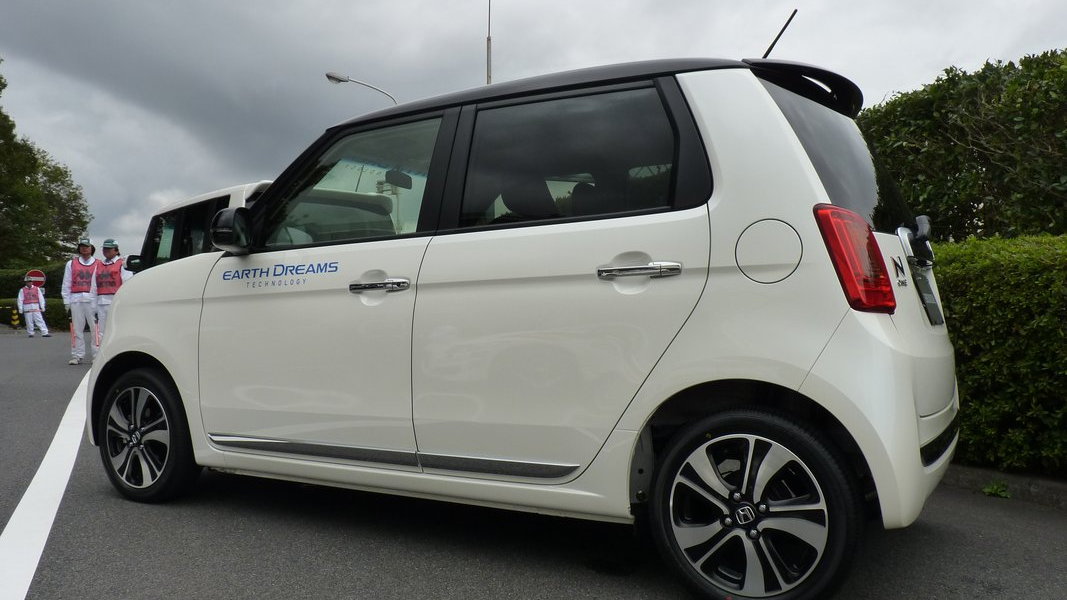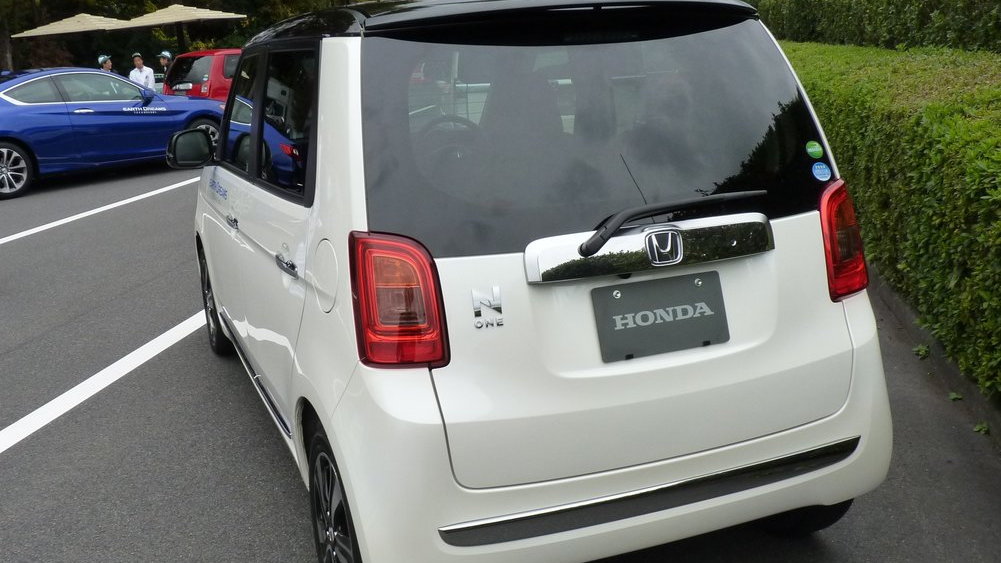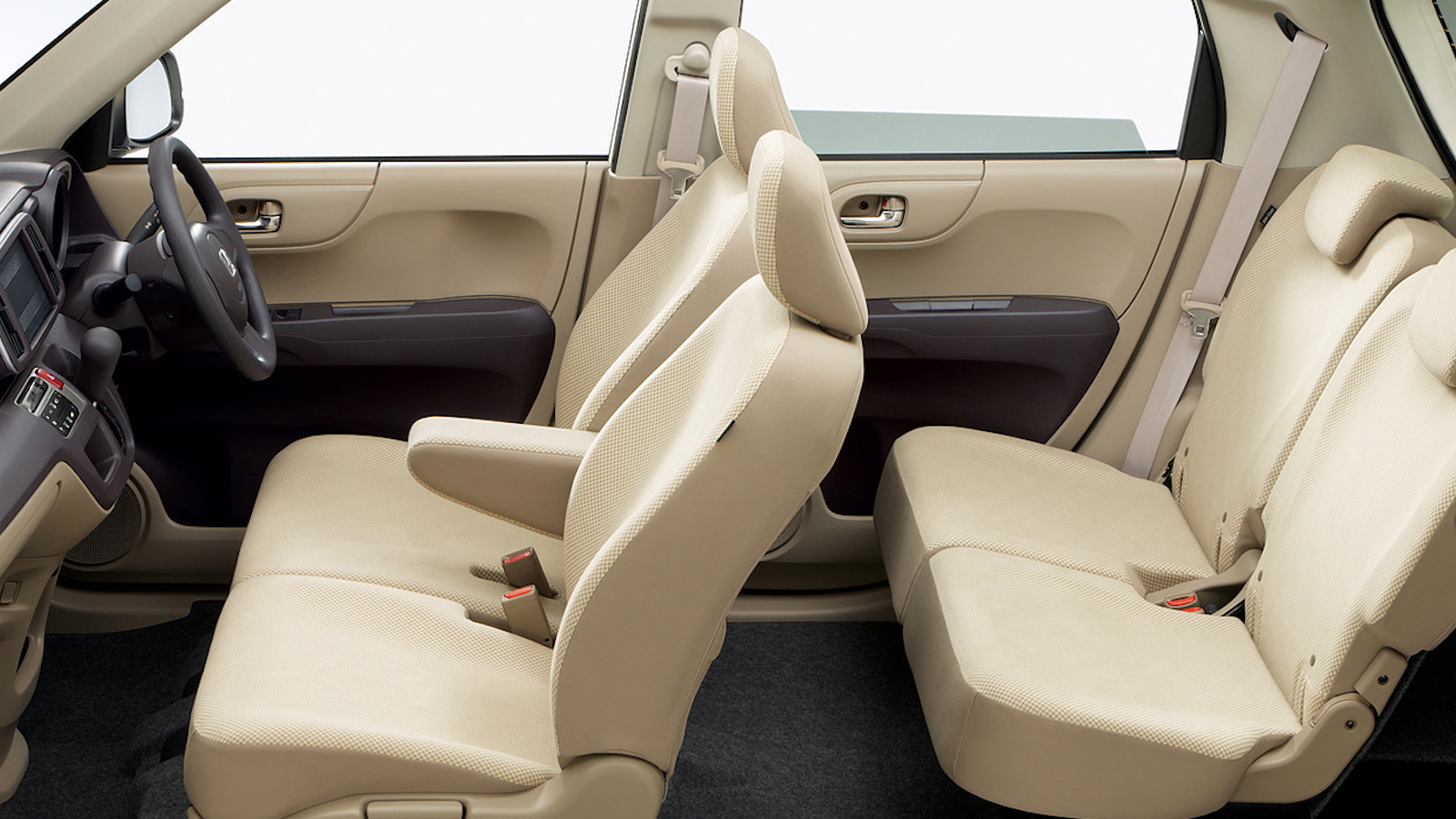It's possible at first glance, from a distance, to liken the N One to the Mini Cooper or Fiat 500 and see it somehow fitting in on U.S. streets; but the truth is that it's tiny. Get a little closer and the cuteness gives way to a sense of distorted, almost toy-like proportions—at least considering the proportions Americans are accustomed to in small cars.
The N One is smaller than what we'd call a minicar in the U.S.; it fits under Japan's popular kei car class—restricted in engine size (660 cc) and horsepower (63 hp), as well as size (less than 133.8 inches long, 78.7 inches tall, and just 58.3 inches wide). In other words, that's about six inches shorter and narrower than the two-door Fiat 500—and narrower than a Smart Fortwo—for vehicles that typically have four doors and are okay for four adults.
You'll forget about the N One's very tiny exterior once you're inside. If you think the Honda Fit we get in the U.S. is packaged well, you get more of the same in the N One. With a near-flat floor that extends the length of the vehicle—thanks in part to a fuel tank that's under the driver's seat—the N One has a surprising amount of space. Front and rear seats are surprisingly well contoured, and I found myself comfortable in front or in back. With the very narrow body you're always pretty much elbow-to-elbow with your passenger, however.
Would an N One feel right on California One?
The other open-ended question is whether even one of the most 'butch' kei cars like the N One could fit in on U.S. streets and highways. At a recent Honda R&D technology session in Japan, we got a chance to put this kei-mini through the paces, oddly enough on Honda's high-speed oval at Tochigi, with varied speeds and some makeshift slaloming to get a feel for it.
The N One we drove was essentially a top-of-the-line, fully loaded model, including the optional turbocharging—raising output of the 660-cc three-cylinder engine to to the max. We've driven a few kei cars in the past and haven't always been impressed by their powertrain smoothness, but this all-wheel-drive N One started to a silky purr and stepped away confidently.
The little three-cylinder engine starts up with a somewhat more gruff note than Honda's four-cylinder engines, and it develops an almost motorcycle-like howl when you press the accelerator. While we found both of those traits endearing, what we didn't find as endearing was the continuously variable automatic transmission (CVT), which clearly doesn't follow Honda's new strategy for constant Gs. It felt truer to older CVT designs, raising revs around the 4,500-rpm mark in moderate acceleration and keeping them there until reaching a cruising speed. With only 77 pound-feet of torque for around 2,000 pounds in this top-of-the-line version, it's not quick, but the CVT keeps revs up—pretty much above the 3,500 mark whenever accelerating even lightly.

Honda's N-One retro minicar - image: Honda Motor Co
Americans tend to do a lot of driving on the Interstate at speeds of 60-70 mph (or in some places, considerably higher), and this is where the N One's practicality for Stateside (or even European use) starts to fall apart. Its rather quick-ratio steering, while on the light side, feels well-weighted, but by the time we reached 120 km/h (75 mph) it felt somewhat darty on center, there was a faint shimmy from the front end, and engine noise became a serious issue (we couldn't imagine cruising for even 10 miles this way). That said, it could accelerate from 50 to 70 mph with unexpected ease and confidence, and this little car felt frisky and eager at city speeds.
Driving the N One felt perfectly normal, except for the narrow cabin. The seating position in front wasn't nearly as mushed-forward and van-like as we expected, and a middle beltline along the dash houses all the important controls for climate and audio.
While a number of small-car enthusiasts have already rallied for the N One here in the U.S., we can't imagine the automaker ever bringing it to the U.S. in its current form—in part, because of its narrowness, but also because of safety. While the N One might be a very safe vehicle in Japan, when we asked an engineer point-blank if this model passes U.S. regulations, he shook his head without hesitation and pointed to the side pillars and roof.
Barriers for U.S. sale: safety and fuel-efficiency
An American Honda representative put it this way: Honda generally aims for no-compromises top safety ratings in every category for cars it sells in the U.S. And since it wasn't originally engineered for the U.S., the N family (including the N Box) might pass regulations for Stateside sales but wouldn't meet those company expectations.
The other issue would be fuel-efficiency. While kei cars might get quite good gas mileage at low speeds, they tend to suck fuel at surprisingly fast rates at American highway speeds—so a car like the N One might not prove to be much more efficient than a Fit on U.S. roads.
Meanwhile, the Japanese auto industry is having trouble making money from kei cars. The combination of shrinking auto sales, and decreasing interest from the younger generation in kei cars (they want larger cars, or not at all) is putting a pinch on a market that once flourished.
Next time? We think a retro-Civic design along the lines of the N One—a little wider and longer, and perhaps a little less boxy—would be an American small-car bullseye.



















